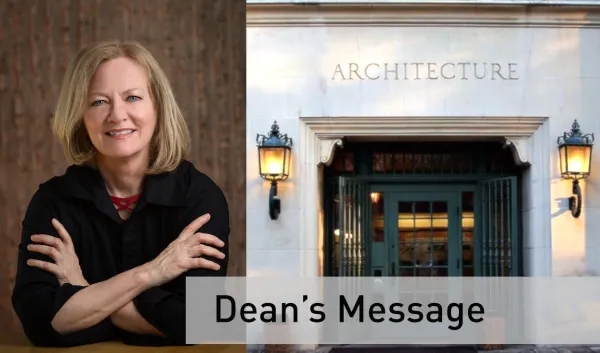Looking Forward: A Message from Dean Michelle Addington

July 6, 2017
My first week as Dean of the School of Architecture has been greeted with warmth (human and environmental!), generosity, and curiosity. As an outsider who has spent the last thirty years living, working, and teaching in the Northeast, primarily at private universities, I arrived on campus last week to assume the leadership of one of the nation’s premier public schools of design for the built environment, a school that is distinctly of its place—Texas.
Although I had visited the UT Austin campus several times over the years for symposia and, more recently, during the dean search, my knowledge of the school had been formed through external impressions. Interactions with faculty at conferences, reading faculty scholarship, experiences with graduates who became my advanced students at Harvard and Yale, and encounters with alumni throughout the world shaped my perception of the School of Architecture and its community. These impressions were inherently framed through the lens of my architectural history and theory classes, where I studied the seminal legacy and contribution of the school in developing the modern pedagogy of design education. The University of Texas at Austin School of Architecture seemed a storied place, standing distinctly apart from the New York/Ivy League cloister to the East and the LA/Asia consortium to the West. In the months since my appointment was announced, and, even more so, during these past few days on campus, I have started to recognize an underlying current here that is perhaps not so evident to the casual observer. In each and every encounter—from the staff members who have patiently and professionally walked me through systems and procedures, to the faculty who have shared their ideas about research agendas and course plans, to the students who have engaged me with questions about priorities for the school, to the alumni who have sent thoughtful and constructive notes and suggestions—I have witnessed a deep and abiding commitment to the continuing integrity of the school and its mission to serve each and every one of its constituents, including the disciplines and professions at large.
In the slipstream of this current is the recognition that the steadfast maintenance of such a profound commitment will ironically require change as local and global circumstances emerge, shift, and evolve. While there is unquestionable pride, and deservedly so, in the school, its history and current standing, there is also a desire to articulate a future that is progressive in its vision yet secure in its prospects for students.
Design for the built environment has traditionally been described as emanating from both the Arts and Sciences. This very description is perhaps the first aspect that should be reconsidered. What distinguishes us from the Arts is that we deal with tangible production in the service of the public realm. We have profound responsibility for determining the physical fabric of society, a fabric that provides, first and foremost, for the health, safety, and welfare of all populations, yet also manifests as the physical repository for a society’s values as well as the scaffold for how cultures define themselves and their aspirations for the future. What distinguishes us from the Sciences is the fluidity and openness of our methods. We readily escape the causal or deterministic lineage from problem to solution that sometimes constrains the Sciences to atomized and narrow questions. The problems and questions of today and tomorrow are not neatly bracketed into isolated chunks that single and stable methods can readily resolve. Differing domains and multiple constituents layer, intercede, intervene, contraindicate, disrupt, or converge. The methods of the design disciplines, regardless of whether appropriated from without or evolved from within, are nimble enough and extensive enough to afford a comprehensive investigation into extraordinarily complex and messy problems.
The design disciplines are uniquely suited to both conceptualize and actualize solutions in today’s rapidly changing world. If, for centuries, the physical product of design was the stable and essential core of the profession, then today we might say that method, as contingent and transient, is not only an equally essential core, but also the means through which we can extend our territory. This paradigm does not erase or reduce our traditional roles. Rather, it opens our purview and presents opportunities and solutions that are only imaginable and realizable through design thinking. The exquisite pavilion is a part of our corpus, and always will be, but so is the negotiation of a contested boundary. Together, I hope that we can begin to chart our possible futures, yet remain wedded to the essential core of our respective disciplines.
The headline of the July 10, 2017, edition of The New Yorker magazine stated, “America’s Future is Texas.” Let’s tweak that a bit and say, “The future of design is The University of Texas at Austin School of Architecture.”
D. Michelle Addington
Dean
Henry M. Rockwell Chair in Architecture

